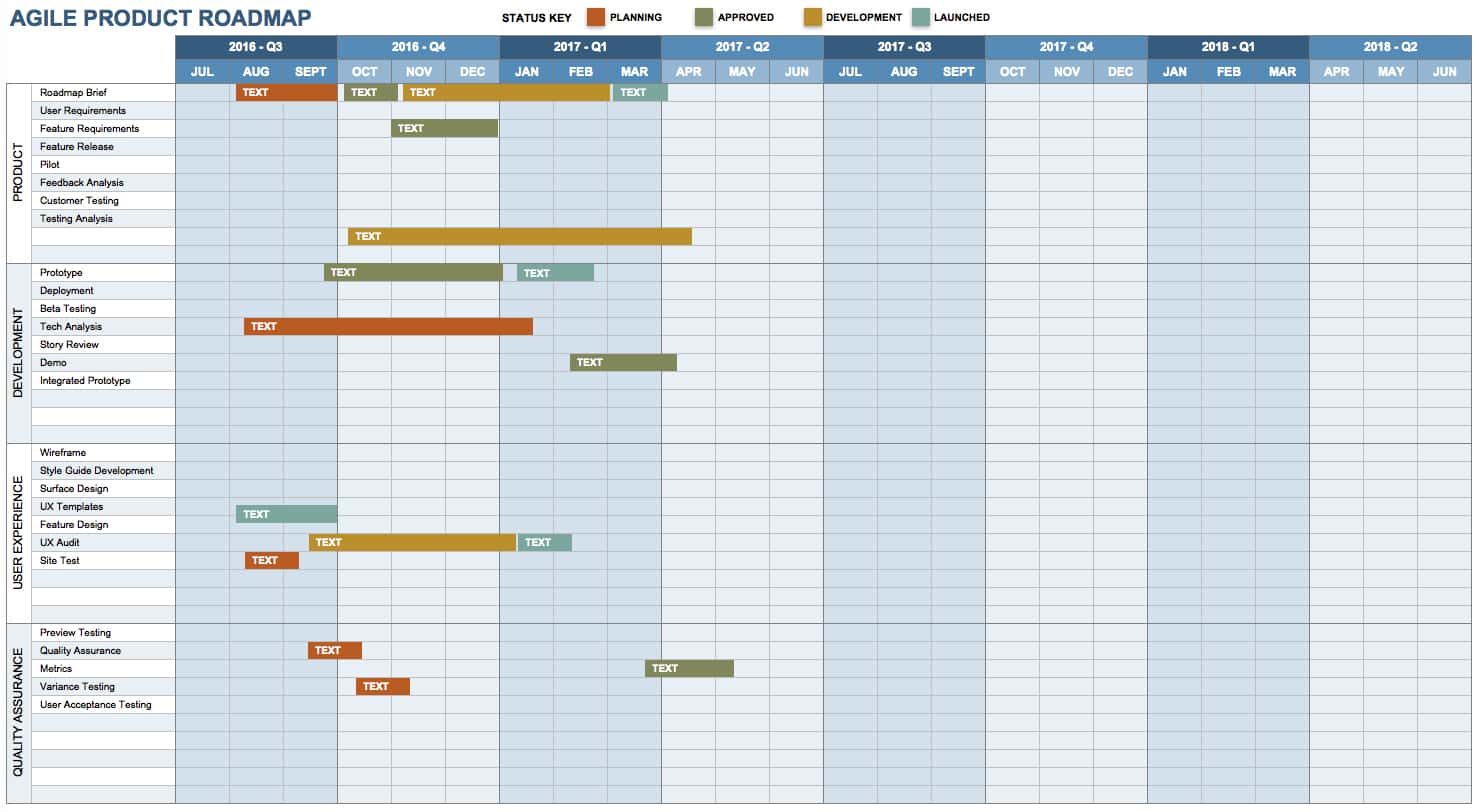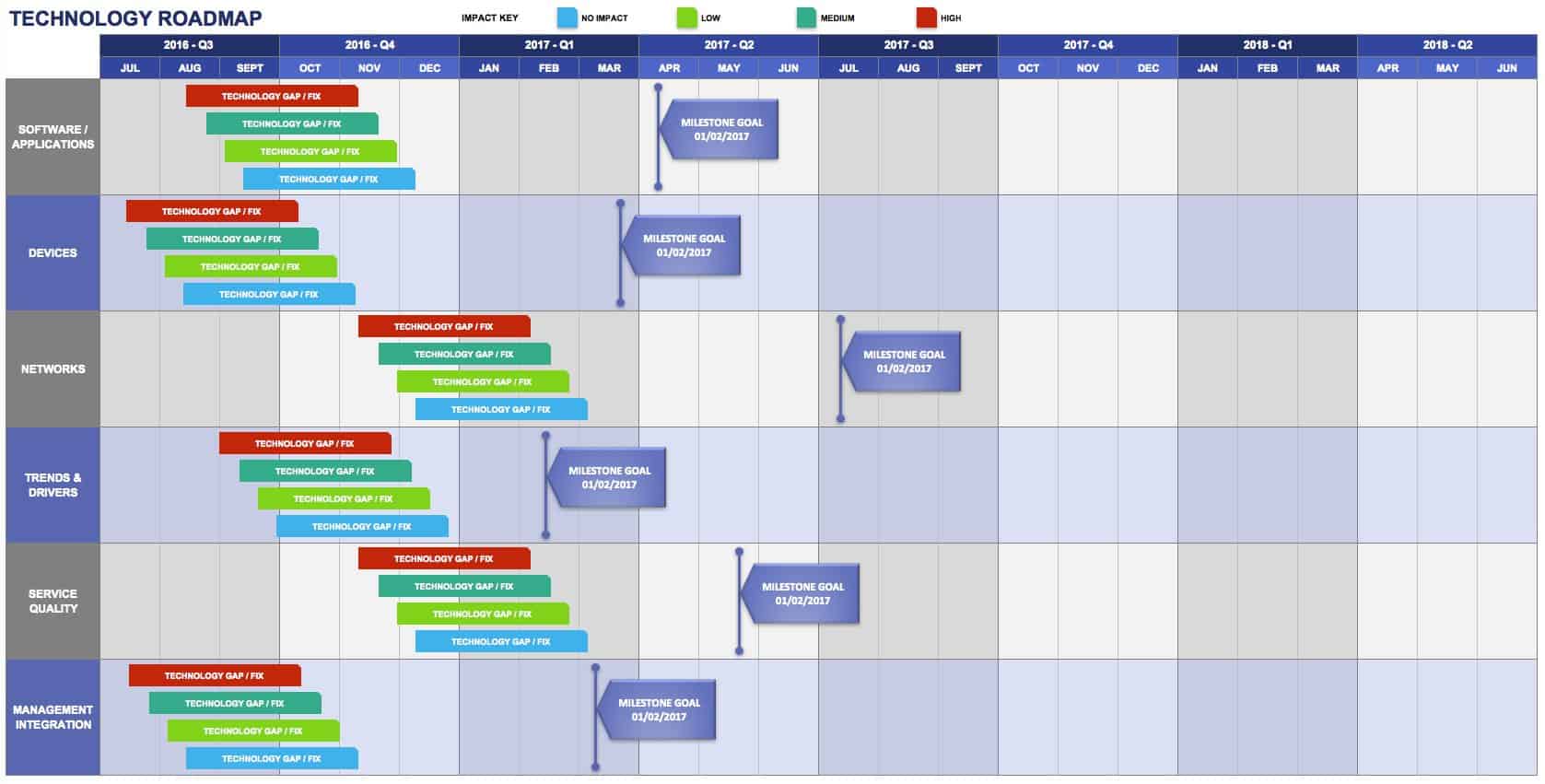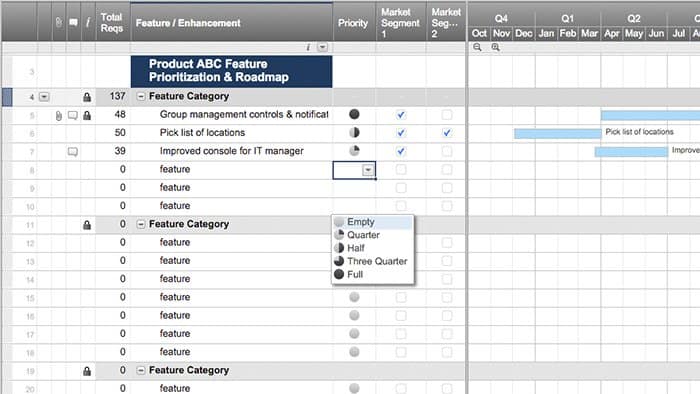Key Uses and Benefits of Technology Roadmaps
With a technology roadmap (TRM), an organization can identify what technology it needs (or how it can adapt the technology it already has) to accomplish specific business goals. These can be goals for the near future or major objectives for several years out. In addition, the TRM defines the core processes regarding when and how the technology solution will be implemented. For senior company executives, technology roadmaps provide information they need to make sound technological investments. For example, a TRM answers questions such as:
- What is the current state of all technology across the entire organization?
- Are the right technologies in place to support the organization’s core capabilities as well as its critical business functions should the organization experience an unanticipated disruption?
- Is there different technology supporting similar capabilities within the organization that can be leveraged?
As businesses grow, IT will also need to adapt and in many cases, significantly expand. Effective planning helps keep technology costs down and reduces the organization’s overall exposure to risk. Technology roadmapping can also be used during the company’s expansion or transition period, like during company acquisition or relocation. Here are some types of IT projects that can be facilitated with TRMs:
- Software migrating
- Unifying disparate systems
- Business continuity
- System upgrades
- Building new technology (virtual and hardware infrastructure)
Who Benefits From Technology Roadmapping?
Roadmapping is a collaborative effort that typically involves engineering, development, and technology teams. Input from third-party stakeholders who will use the systems also often participate in the initial and final roadmapping stages to help ensure usability. However, every organization has different types of stakeholders, and each stakeholder brings different concerns and expectations.
For instance, chief information officers (CIOs) usually care more about strategic plans and whether or not their technology choice will help them achieve their strategic business goals. By contrast, data center architects want to know about the infrastructure of emerging technology. However, IT roadmaps serve a range of stakeholders, especially in large enterprises where technology systems can be complex. CEOs, product managers, and project teams are among many key stakeholders that can benefit from a technology roadmap.
Here’s what a technology roadmap may look like:
Types of Technology Roadmaps
While taxonomy and processes vary across industries, there are two main categories of technology roadmaps used by large enterprise environments: the product technology roadmap and the emerging technology roadmap.
The product technology roadmap is driven by the product’s needs. It helps IT executives identify which technologies can improve a product’s functions or extend the use of that particular technology. By contrast, the emerging technology roadmap focuses on forecasting and decision making around the development of a single product in the infancy stage. The implication with these emergent maps is that as the technology develops, so will the uses for it.
Knowledge and Skills for an Effective Roadmap
To create a successful roadmap, you must have deep contextual knowledge of the area. For instance, if your IT roadmap is for a commercial banking business, then you will need to understand the systems and processes within commercial banking. Otherwise, you cannot effectively determine the needs.
Additionally, past experience in roadmapping is helpful. However, if you have worked as a project manager, product manager, program manager or business analyst, you probably already have developed skills to gather and organize large volumes of technical data. In fact, those with significant experience as a facilitator, consultant, or corporate trainer will likely adapt well to the roadmapping role because throughout the process you’ll engage in numerous discussions with stakeholders.
Ultimately, the key indicator of successful roadmapping is the ability to interpret technological information and communicate it clearly to non-technical audiences, as well as to top-level executives who won’t be afraid to ask tough questions.
What Should a Technology Roadmap Include?
IT roadmaps offer a wide range of flexibility. There are no set standards for what TRMs must include, so it’s important that you remain mindful of the particular needs for your business. Below are core elements that technology experts suggest your roadmap includes.
Start with a goal: “A critical element of a technology roadmap is identifying the strategic goals the organization wishes to achieve,” says Michelle Nessman, President and Founder of Elite Business Systems. “From the goals, you then identify the technology solutions that would help meet those goals. If your technology-based decisions are merely based on what your organization is currently using, then you end up getting a very limited perspective on possible solutions. A technology roadmap with clearly defined goals allows the organization to assess in house systems, as well as systems they may have never even thought of.”
Focus on key priorities: “Roadmaps are not lists! I can’t tell you how many roadmaps I’ve opened only to see a wish list of activities,” blogs Ross Brindle, CEO of Nexight Group. With technology constantly evolving along with the challenge of planning for the future, it’s easy to see how IT roadmaps can go sideways. By communicating through your roadmap that you know why, what, how, and that you have an action plan, you stay connected to your business strategy and maintain a sense of key priorities, even when you’re presented with new information.
Gather input from suppliers: “The beauty of the Roadmap is that it allows for a larger perspective on technologies,” states John Carter, author of Innovate Products Faster. This emphasizes the importance of making the roadmap a collaborative process. According to Carter, a technology roadmap is more robust when it includes perspectives from business partners and suppliers. He suggests spending time outside of the office developing technology partners as that is how you establish a true sense of the competitive landscape and how you can discover technology alternatives that can help you improve your company business positioning.
Casey Kopp has helped many Fortune 100 companies in the cloud computing, financial services, and hospitality industries analyze their processes and implement process improvement initiatives. He recommends that every organization create an IT roadmap. “Having a functional roadmap does more than help you build for future needs, it helps you respond more easily when new issues arise because the roadmap gives you a true sense of your portfolio and its current state,” Kopp says.
Kopp also offered these next three tips:
- State your mission: “Your IT roadmap should have a blatant mission statement that conveys the strategy for the roadmap,” states Kopp. This usually comes from the CEO, CIO, or CMO in the form of an initiative list—which can be extrapolated into a mission statement. When you have a mission statement you help everyone involved understand the overall goals.
- Create a tactical list and prioritize it: These tactics directly relate to the goal(s) outlined in the mission statement. Tactics are generally high-level initiatives; each tactic should have a timeline associated with it, and be comprised of smaller tasks or jobs (also with timelines) that can be assigned to an owner.
- Pair your tactics to a budget (or cost estimation) and a business case. “Many times this step will help determine the priority and serve as a checkpoint if priorities shift,” says Kopp.
Finally, Andrea Saez, head of Customer Success at ProdPad, says that your roadmap should be visual, accessible, and clear enough for anyone to scan for these three questions:
- What are we doing?
- Why are we doing it?
- How does it tie back to our objectives?
Potential Challenges
Despite the value that IT roadmaps can provide, there are some potential challenges. Below is a list of common problems teams face when creating a roadmap so that you can be aware of the drawbacks before you get started.
- Alienating stakeholders: “A particular challenge I come across when organizations move forward with creating a technology roadmap is that stakeholders haven’t been engaged,” states Michelle Nessman, Founder and President of Elite Business Systems. Without early buy-in, you may find yourself hunting for and chasing after stakeholders in order to get necessary approvals.
- Setting aside priorities: Nessman also noted that when priorities are ignored or go without monitoring, budgets become impacted—often with overruns. “Many companies have started shifting to having a technology committee,” says Nessman. This eliminates the ‘IT only’ perspective and prevents decisions being made to favor the concerns of IT teams.
- Inaccurate or fragmented information: If the system data is not accurate or complete, the quality of your roadmap declines. You can avoid credibility issues by diligently reviewing your system data before you begin roadmapping. If your organization has subject matter experts, tap into their expertise. If not, seek out industry analysts, suppliers, or the help of consultants. Keep in mind technology roadmaps are packed with detail. Additionally, the mission statement, business strategy, technologies, priorities, activities, and timelines should all link.
Understanding these challenges will help you overcome them when creating your own IT roadmap - rather than backtracking when the process becomes unmanageable.
Technology Roadmapping Tools
As mentioned, there’s no true, set-in-stone format for building IT roadmaps. However, there are several software tools that can help you get started creating and managing your roadmap. Here are some for you to explore.
- Product Plan helps you build technology roadmaps and prioritize your initiatives. Use one of their many templates to help you get started, including tailored technology roadmaps for enterprise or IT architecture.
- Roadmunk offers spreadsheet templates that guide you through data fields as well as rich featured presentation software.
- Excel also offers several roadmapping templates, such as the “Technology Roadmap” template, that you can use to store all project information in a familiar spreadsheet layout.
- Smartsheet is a cloud-based work management tool that offers free technology roadmap templates.
Create a Powerful Technology Roadmap with Smartsheet
Empower your people to go above and beyond with a flexible platform designed to match the needs of your team — and adapt as those needs change.
The Smartsheet platform makes it easy to plan, capture, manage, and report on work from anywhere, helping your team be more effective and get more done. Report on key metrics and get real-time visibility into work as it happens with roll-up reports, dashboards, and automated workflows built to keep your team connected and informed.
When teams have clarity into the work getting done, there’s no telling how much more they can accomplish in the same amount of time. Try Smartsheet for free, today.


